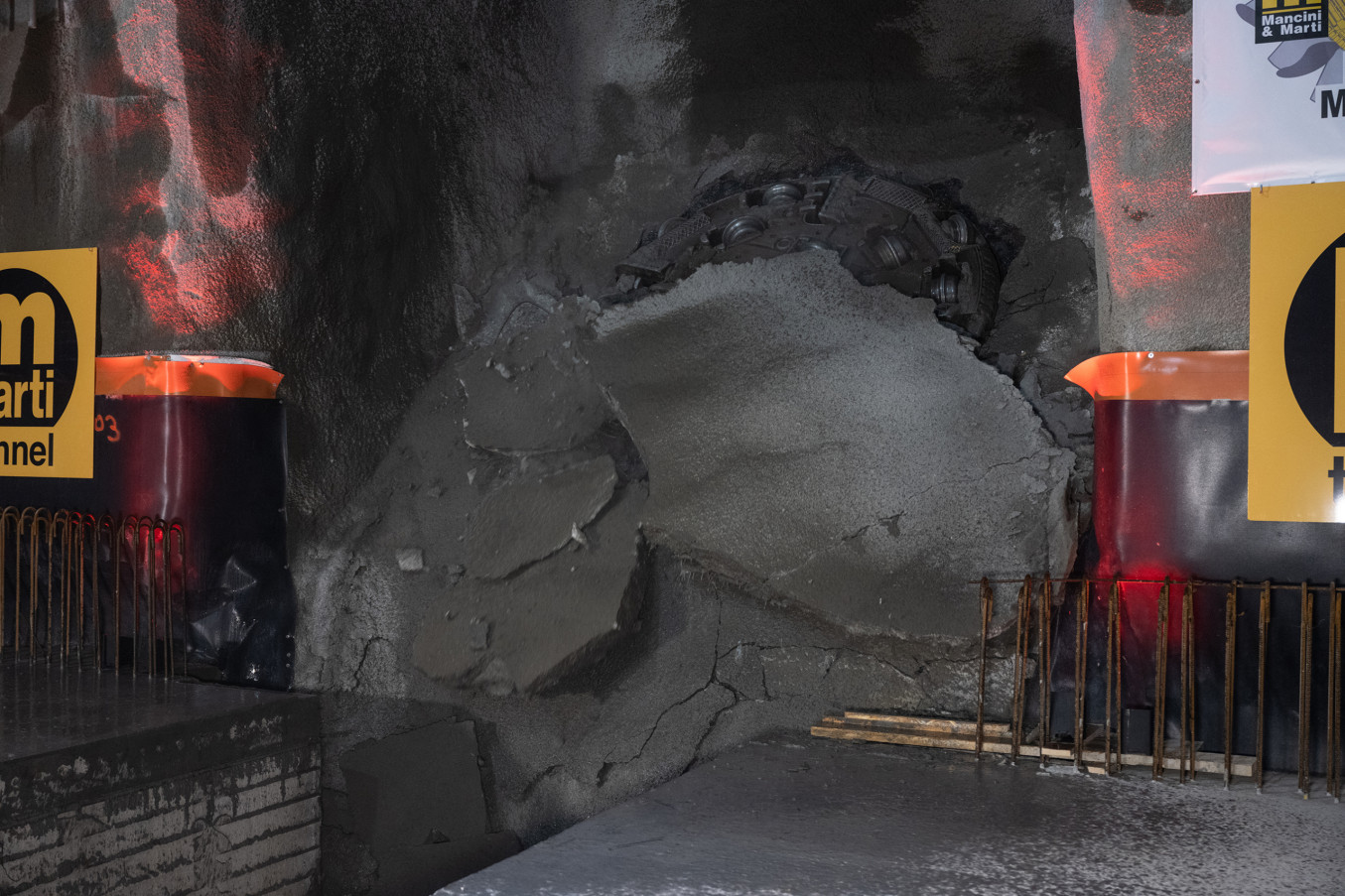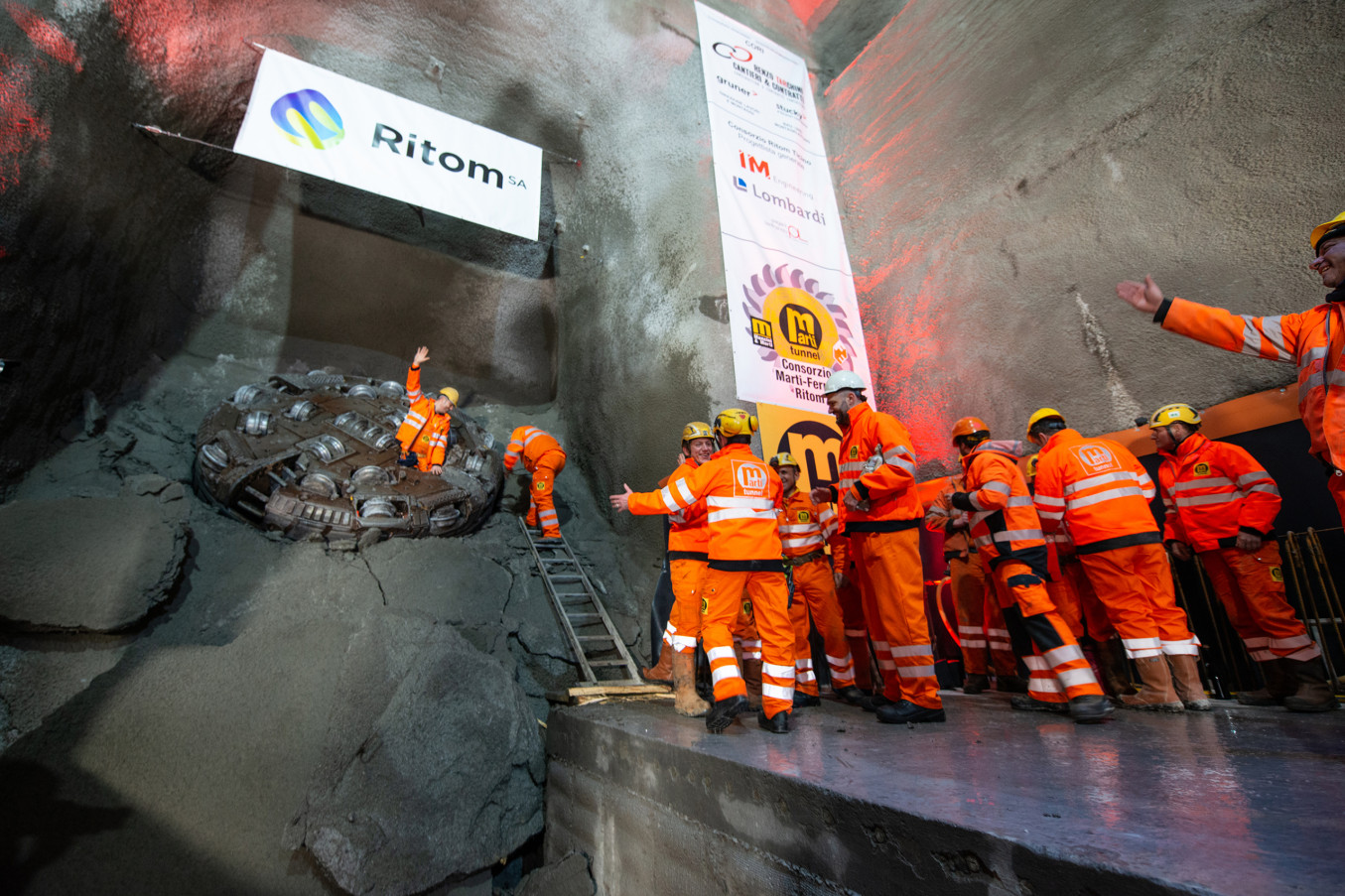
Breakthrough at the Ritom inclined shaft
The Ritom power plant in Ticino, which was built in 1920 and is located only a few kilometers from the Gotthard Tunnel, is in need of renewal. Since 2018, a number of contractors from the Marti Group have been working on this overall complex renovation on behalf of Ritom SA. In February 2022, Marti will pass an important milestone with the breakthrough of the inclined shaft to Lake Ritom.
It is Wednesday, February 23, 2022, shortly before half past ten in the morning. The miners from Marti Tunnel are anxiously waiting for the rotating drill head of the tunnel boring machine (TBM) to stop. Just a few minutes earlier, the TBM broke through the shaft wall of the slide cavern in Piora at the top. The valve cavern structure is located 40 m underground and only a few meters from Lake Ritom. Some 800 m further down in altitude, the invited guests at the Piotta portal in the start cavern are enthralled by the moment as it unfolds via livestream. The time has now come; the machine is stopped and the first member of the tunneling crew climbs through the narrow manhole. With cheers and applause, he hands over the statue of St. Barbara to his colleague, who is already waiting for him on a ladder, in keeping with the old tradition. One by one, the remaining crew members climb out of the machine. They are received by their comrades, who are visibly moved and highly emotional. After all, the journey they have come on has not been an easy one.
Pressure Gallery from Piotta to Piora
Work on the pressure gallery for the renovation of the Ritom power plant in Piotta started with the excavation of the lower pressure gallery in 2019. Here, some 600 m were excavated at a gradient of approx. 0.5 % using underground blasting. After about 450 m, the tunneling crew came across a massive water inrush, with up to 200 l/second entering the gallery. This forced them to stop driving operations temporarily. They employed an injection campaign that spanned several months to combat the water and seal the tunnel so that it could be excavated again. At the end of 2020, the start and assembly cavern at the end of this pressure gallery was completed. There, the TBM was assembled and prepared for driving on a starting ramp. The gripper TBM, with a diameter of 3.2 m, was developed by Herrenknecht AG in collaboration with Marti specialists specifically for the construction of this sloped shaft. Thanks to the backloading drill head and a double, mechanically self-locking backloading system, it meets the highest safety standards. Ventilation installations were also added to the greatest extent possible and the workstations were optimized for the slope.
In March 2020, the TBM started driving operations toward Lake Ritom. The slope started at 42 % (just under 23°) and after about 800 m, the slope was increased to 90 % (42°) within a radius of 150. 451 m after the start cavern, the machine drove into a rough fault, a cleft with loose rock. The experienced crew assessed the situation with exploratory drilling and stabilized the cavities with spiles and cement injections. Once this had been secured, it was possible to pass through the fault zone. Steel liner plates ensured that the machine was securely braced during the critical phase. Alarmed by this incident, the company carried out exploratory surveys on the rest of the route to check for expected fault zones and to secure them in advance. Although this led to delays, it also prevented prolonged downtimes.
“I am extremely proud of what our people are accomplishing here.”
The Diversity of the Marti Group
While digging takes place in the mountain, various other operations for the overall project are running at the same time. At the portal in Piora near Lake Ritom, Marti Tunnel constructed the valve cavern with a 40 m deep shaft leading to it. This part of the construction site is difficult to access in winter. Due to the danger of avalanches, the access road is partially closed and the team is flown in by helicopter. The supply of construction materials and equipment is, however, ensured at all times via the material ropeway.
The Marti Basel metalworking facility produced structural steelwork and infiltration elements for the portal in Piora. Marti Technics Ltd. also participated in fitting out the start tube and ramp and provided the conveyor belt and silo for the excavated material. In the start cavern, a separation system from Simatec separates the excavated material from the water and Alwatec then ensures optimum wastewater treatment. Stump BTE carried out the exploratory drilling in the gallery leading to the start cavern, which allowed the geology from the water infiltration to be investigated in greater detail. The professionals from Marti Geotechnik GmbH (Renesco) used these exploratory surveys as the basis to plan and carry out the necessary injection work. Last but not least, Mancini & Marti is in charge of the inner lining of the new power plant control center and the civil engineering work on the equalizing basin together with a construction consortium partner in the outer area.
Thanks to the diversity of the Marti Group, the response times throughout the project were and are short and efficient. It was possible to solve virtually all difficulties quickly and without unnecessary red tape, thanks to the internal expertise and with the experience and knowledge of the seasoned professionals. The work in the sloped shaft in particular requires tremendous physical performance by the tunneling crew. Sergio Massignani, project manager at Marti Tunnel, is naturally exceedingly proud of his team. After all, building a sloped shaft at this inclination is a very particular challenge that does not arise every day. During his short speech, he praises and thanks the team extensively before the TBM breaks through the last few meters.










